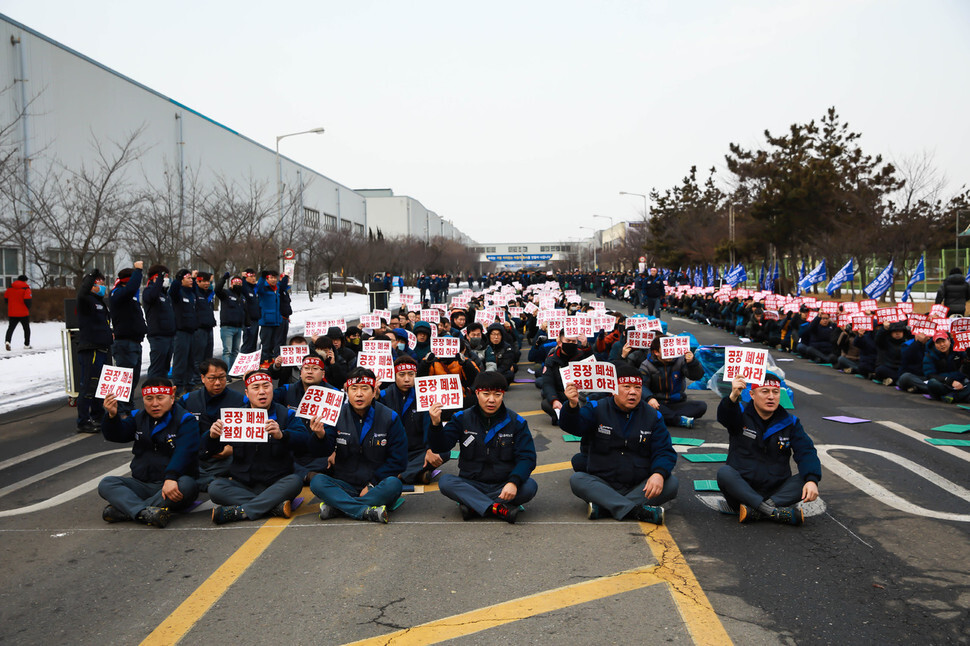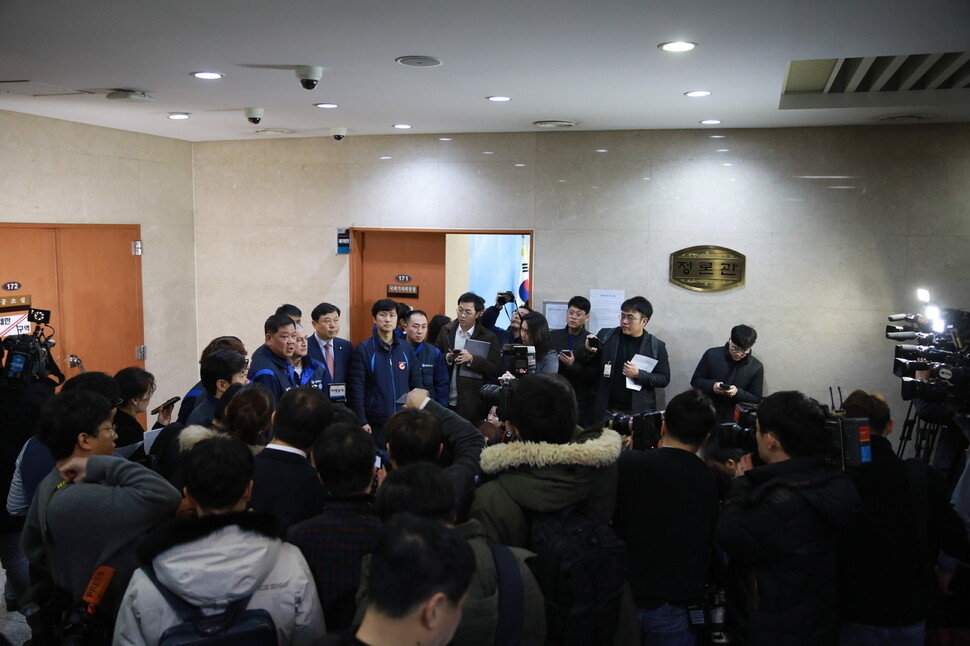hankyoreh
Links to other country sites 다른 나라 사이트 링크
GM Korea workers’ anger mounts toward corporate headquarters following closure of Gusan factory

The firestorm over GM Korea’s decision to shutter its Gunsan plant continues to rage. The employment crisis triggered in Gunsan is triggering fears for 16,000 GM Korea workers at factories in the North Jeolla city, as well as Incheon’s Bupyeong neighborhood in Gyeonggi Province and Changwon, South Gyeongsang Province.
Anger among workers is also growing toward the GM corporate headquarters’ so-called “slash-and-burn” approach to management: sucking up massive amounts of interest, operational support funds, and technology licenses as if through a straw, while leaving GM Korea itself riddled with debt.
■ ‘First Daewoo, now GM . . . how could this happen twice?’
“K”, 55, first went to work at Daewoo Motors’ Bupyeong plant in 1986 and is currently a production worker at the GM Korea factory in Gunsan. Just before the Lunar New Year holiday (Feb. 16), he received a special delivery from the company requesting his voluntary retirement and resignation. The letter came 17 years after K received his layoff notification from Daewoo in 2001.
“My wife asked, ‘How can they [the company] do this twice?” an audibly embittered K said in a Feb. 20 telephone interview with the Hankyoreh. “I feel betrayed and depressed.”
K can clearly recall the moment when over 1,700 workers were let go in 2001 after Daewoo’s bankruptcy.
“At that time, it was a situation of ‘if you aren’t fired, it’s going to be me.’ I had children in the sixth grade of elementary school and second year of middle school, so my immediate concern was survival,” K said.
After losing his job, K opened a chicken restaurant. He handled delivery duties himself, but struggled as a first-time businessman.
“We made just enough to send the kids to school,” K remembered. In 2003, labor and management reached a deal to reinstate the laid-off workers. K closed down his chicken restaurant and went back to the factory.
In 2005, K was assigned to the newly opened diesel engine factory in Gunsan. He promptly moved to the city, with plans to remain until retirement age. For the first few years, everything was fine. Eventually, GM began reducing the volumes at its Gunsan plant before finally shuttering it completely on Feb. 12. GM corporate headquarters would arbitrarily add to and subtract from the production volumes at its plants; worker livelihoods would fluctuate as a result. K was left with the impression that the corporate headquarters “looks at GM Korea as a subcontractor.”
“They use volumes to get the factories competing, and the GM corporate headquarters reaps all the rewards,” he said.
Having already experienced life outside the company, K is deeply worried.
“Back when the layoffs happened in 2001, there were procedures in place for supporting career changes, but almost nobody was successful,” he remembered. “And with the economy in Gunsan so bad, it’s going to be tough finding other work.” K is now wondering whether he is going to have to open another chicken restaurant.

■ R&D efforts for the corporate headquarters: Where did the payoff go?
The sense of victimization at the hands of the GM corporate headquarters isn’t only felt by workers at the Gunsan plant. Data drafted by the office branch of the Korean Metal Workers’ Union GM Korea chapter based on auditing reports show that 1.5 trillion won (US$1.4 billion) of GM Korea’s cumulative deficit of roughly 2 trillion won (US$1.9 billion) for 2012–2016 was in the form of payments to GM’s corporate headquarters, including interest and operational support funds.
According to the labor union, GM Korea spent 2.9926 trillion won (US$2.78 billion) on technology development over the same period, while the GM corporate headquarters paid just 477.1 billion won (US$443.0 million) to GM Korea for technology fees. It’s a situation that has many GM Korea R&D workers wondering just where the payoff for their efforts went.
“Since the change to GM Korea in 2011, there have been more GM corporate headquarters’ duties than GM Korea ones,” said “J,” a research worker at the Changwon plant. The South Korean-produced Trax, its sister model the Buick Encore, and the Holden Mokka were all developed by GM Korea. Related duties are handled uniquely by GM Korea among all GM brands worldwide. GM Korea has also been developed a large-capacity gasoline engine for the GM head office – an engine it does not produce.
“GM Korea spent the money to develop everything, and the company won’t explain how much the head office received or where the patents went,” J said.
In the past, GM missed several opportunities to sell during the liquidation of Swedish subsidiary Saab because of its insistence on monopolizing intellectual property rights – a process that ultimately led to Saab going bankrupt.
“I don’t know if the company was facing problems because of mistakes by the workers or GM Korea management, but GM Korea’s activities to date have been at the level of production to meet the work assigned to it by GM’s corporate headquarters,” J said of the Gunsan plant shutdown announcement.
“A multinational corporation needs to allocate at least some of its profits to maintaining local subsidiaries. GM had been taking all the profits for itself and leaving the other countries and their workers to suffer,” J said.
■ With the crisis looming, workers may be pitted against each otherAs workers both in the office and on the assembly line at GM Korea are racked by feelings of anxiety and loss, there are also concerns that they may be forced to take sides as the crisis intensifies. Lee Beom-yeon, 56, has been working on the production line at GM Korea’s Bupyeong factory for 29 years now, since getting a job at Daewoo Motors in 1989 as a student activist. In Dec. 2017, Lee published a book called “30 Years on the Job: From an Infiltrator to a Veteran Worker,” which takes a critical look at labor unions for regular workers at large corporations.
“Moving forward, the GM corporate headquarters is going to try to stir up conflict and division between the regular workers and irregular workers, and between the Gunsan factories and the other factories,” Lee said. Before the layoffs in 2001, Daewoo Motors started by letting go of all the irregular workers and then urged the regular workers to voluntarily resign from the company, telling them that they could return when the situation improved.
“As the anxiety about unemployment continued and as the list of people being laid off was released, personal relationships in the company were devastated,” Lee recalled. “While all of the terminated people were ultimately restored to their jobs, there’s still resentment among the workers even today.”
Faced with the decision to close the Gunsan factory, the job of the labor union, Lee says, is to prop up workers’ feelings of solidarity. “The GM crisis can’t be fixed through the struggle of the labor union alone – we need the larger society to take an interest. And who’s going to feel sympathy for people who are taking sides and squabbling over their own interests? That means the union needs to play the role of bringing workers in various factories and various situations together as one,” he said.
By Lee Ji-hye and Park Tae-woo, staff reporters
Please direct questions or comments to [english@hani.co.kr]

Editorial・opinion
![[Guest essay] Amending the Constitution is Yoon’s key to leaving office in public’s good graces [Guest essay] Amending the Constitution is Yoon’s key to leaving office in public’s good graces](https://flexible.img.hani.co.kr/flexible/normal/500/300/imgdb/original/2024/0416/8917132552387962.jpg) [Guest essay] Amending the Constitution is Yoon’s key to leaving office in public’s good graces
[Guest essay] Amending the Constitution is Yoon’s key to leaving office in public’s good graces![[Editorial] 10 years on, lessons of Sewol tragedy must never be forgotten [Editorial] 10 years on, lessons of Sewol tragedy must never be forgotten](https://flexible.img.hani.co.kr/flexible/normal/500/300/imgdb/original/2024/0416/8317132536568958.jpg) [Editorial] 10 years on, lessons of Sewol tragedy must never be forgotten
[Editorial] 10 years on, lessons of Sewol tragedy must never be forgotten- [Column] A death blow to Korea’s prosecutor politics
- [Correspondent’s column] The US and the end of Japanese pacifism
- [Guest essay] How Korea turned its trainee doctors into monsters
- [Guest essay] As someone who helped forge Seoul-Moscow ties, their status today troubles me
- [Editorial] Koreans sent a loud and clear message to Yoon
- [Column] In Korea’s midterm elections, it’s time for accountability
- [Guest essay] At only 26, I’ve seen 4 wars in my home of Gaza
- [Column] Syngman Rhee’s bloody legacy in Jeju
Most viewed articles
- 1[Guest essay] Amending the Constitution is Yoon’s key to leaving office in public’s good graces
- 2Faith in the power of memory: Why these teens carry yellow ribbons for Sewol
- 3[Guest essay] How Korea turned its trainee doctors into monsters
- 4[Editorial] 10 years on, lessons of Sewol tragedy must never be forgotten
- 5Korea ranks among 10 countries going backward on coal power, report shows
- 6Final search of Sewol hull complete, with 5 victims still missing
- 7How Samsung’s promises of cutting-edge tech won US semiconductor grants on par with TSMC
- 8Pres. Park an accomplice in ordering resignation of CJ Group vice chairman
- 9[News analysis] Watershed augmentation of US-Japan alliance to put Korea’s diplomacy to the test
- 10K-pop a major contributor to boom in physical album sales worldwide, says IFPI analyst